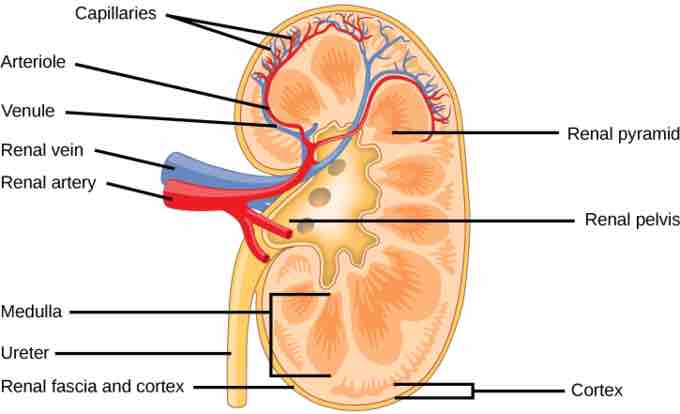There are three major regions of the kidney:
- Renal cortex
- Renal medulla
- Renal pelvis
The renal cortex is a space between the medulla and the outer capsule. The renal medulla contains the majority of the length of nephrons, the main functional component of the kidney that filters fluid from blood. The renal pelvis connects the kidney with the circulatory and nervous systems from the rest of the body.
Renal Cortex
The kidneys are surrounded by a renal cortex, a layer of tissue that is also covered by renal fascia (connective tissue) and the renal capsule. The renal cortex is granular tissue due to the presence of nephrons—the functional unit of the kidney—that are located deeper within the kidney, within the renal pyramids of the medulla.
The cortex provides a space for arterioles and venules from the renal artery and vein, as well as the glomerular capillaries, to perfuse the nephrons of the kidney. Erythropotein, a hormone necessary for the synthesis of new red blood cells, is also produced in the renal cortex.

Kidney structure
The kidney is made up of three main areas: the outer cortex, a medulla in the middle, and the renal pelvis.
Renal Medulla
The medulla is the inner region of the parenchyma of the kidney. The medulla consists of multiple pyramidal tissue masses, called the renal pyramids, which are triangle structures that contain a dense network of nephrons.
At one end of each nephron, in the cortex of the kidney, is a cup-shaped structure called the Bowman's capsule. It surrounds a tuft of capillaries called the glomerulus that carries blood from the renal arteries into the nephron, where plasma is filtered through the capsule.
After entering the capsule, the filtered fluid flows along the proximal convoluted tubule to the loop of Henle and then to the distal convoluted tubule and the collecting ducts, which flow into the ureter. Each of the different components of the nephrons are selectively permeable to different molecules, and enable the complex regulation of water and ion concentrations in the body.
Renal Pelvis
The renal pelvis contains the hilium. The hilum is the concave part of the bean-shape where blood vessels and nerves enter and exit the kidney; it is also the point of exit for the ureters—the urine-bearing tubes that exit the kidney and empty into the urinary bladder. The renal pelvis connects the kidney to the rest of the body.